2014 FIAT GRANDE PUNTO ACTUAL air condition
[x] Cancel search: air conditionPage 118 of 216

117
SAFETY
WARNING
LIGHTS AND
MESSAGES
IN AN
EMERGENCY
SERVICE
AND CARE
TECHNICAL
SPECIFICATIONS
INDEX
CONTROLS
AND DEVICES
STARTING
AND DRIVING
Roof rack/ski rack
Remove the roof rack or ski rack from the
roof after use. These accessories decrease
aerodynamic penetration and have a neg-
ative effect on fuel consumption. It is bet-
ter to use a trailer to transport particu-
larly bulky objects.
Electrical devices
Use electrical devices only for the amount
of time needed. The heated rear window,
auxiliary headlights, windscreen wipers and
fan heater use up a considerable amount
of current, causing increased fuel con-
sumption (up to +25% in the urban cycle).
Air conditioning
Air conditioning leads to higher fuel con-
sumption (on average up to +20%). If the
temperature outside is not too extreme,
try and use the air vents.
Spoilers
The use of non-certified spoilers may ad-
versely affect aerodynamics and fuel con-
sumption.DRIVING STYLE
Starting
Do not warm up the engine at low or high
revs when the vehicle is stationary; this
causes the engine to warm up more slow-
ly, thereby increasing fuel consumption
and emissions. It is advisable to set off im-
mediately and slowly, avoiding high revs:
this allows the engine to warm up more
quickly.
Unnecessary actions
Avoid revving up when stationary at traf-
fic lights or before stopping the engine.
The latter action, like double declutching,
is entirely unnecessary and causes in-
creased fuel consumption and pollution.
Gear selection
Use a higher gear as soon as traffic and
road conditions allow. Using a low gear
for faster acceleration will increase fuel
consumption.
In the same way, improper use of a high
gear increases fuel consumption, emissions
and engine wear.SAVING FUEL
Here are some suggestions which may
help you to save fuel and reduce the
amount of toxic emissions released into
the atmosphere.
GENERAL CONSIDERATIONS
Car maintenance
Have checks and adjustments carried out
in accordance with the “Scheduled Service
Plan”.
Tyres
Check the tyre pressure at least once
every 4 weeks: if the pressure is too low,
consumption levels increase as resistance
to rolling is higher.
Unnecessary loads
Do not travel with an overloaded boot.
The weight of the car (especially when dri-
ving in town) and its arrangement greatly
affect fuel consumption and stability.
111-122 ACTUAL 1ed EN 20-07-2010 16:10 Pagina 117
Page 119 of 216
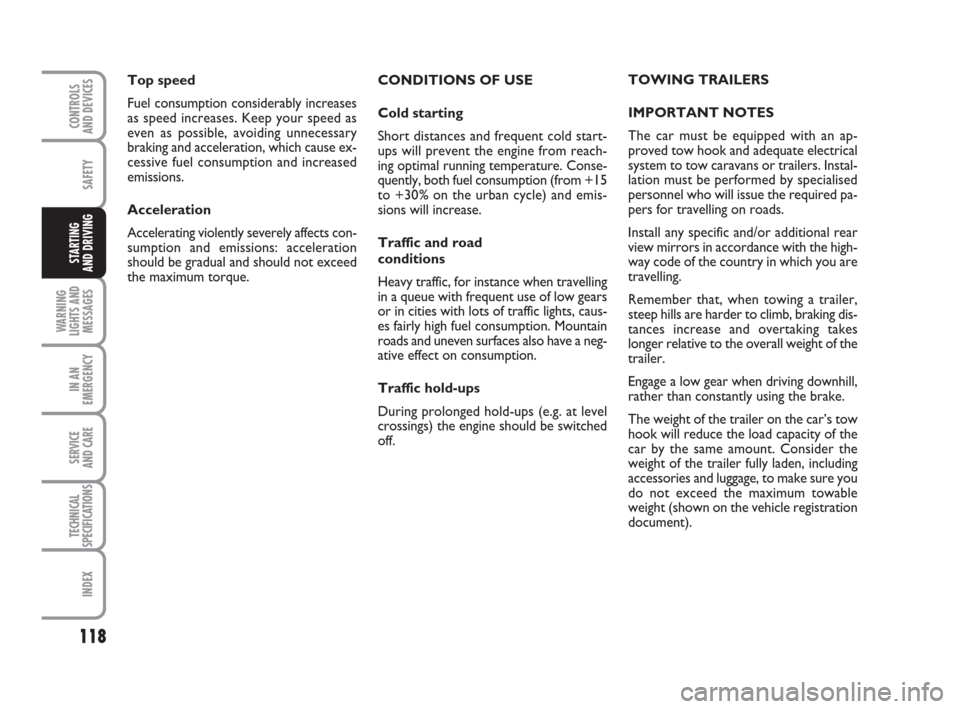
118
SAFETY
WARNING
LIGHTS AND
MESSAGES
IN AN
EMERGENCY
SERVICE
AND CARE
TECHNICAL
SPECIFICATIONS
INDEX
CONTROLS
AND DEVICES
STARTING
AND DRIVING
CONDITIONS OF USE
Cold starting
Short distances and frequent cold start-
ups will prevent the engine from reach-
ing optimal running temperature. Conse-
quently, both fuel consumption (from +15
to +30% on the urban cycle) and emis-
sions will increase.
Traffic and road
conditions
Heavy traffic, for instance when travelling
in a queue with frequent use of low gears
or in cities with lots of traffic lights, caus-
es fairly high fuel consumption. Mountain
roads and uneven surfaces also have a neg-
ative effect on consumption.
Traffic hold-ups
During prolonged hold-ups (e.g. at level
crossings) the engine should be switched
off.TOWING TRAILERS
IMPORTANT NOTES
The car must be equipped with an ap-
proved tow hook and adequate electrical
system to tow caravans or trailers. Instal-
lation must be performed by specialised
personnel who will issue the required pa-
pers for travelling on roads.
Install any specific and/or additional rear
view mirrors in accordance with the high-
way code of the country in which you are
travelling.
Remember that, when towing a trailer,
steep hills are harder to climb, braking dis-
tances increase and overtaking takes
longer relative to the overall weight of the
trailer.
Engage a low gear when driving downhill,
rather than constantly using the brake.
The weight of the trailer on the car’s tow
hook will reduce the load capacity of the
car by the same amount. Consider the
weight of the trailer fully laden, including
accessories and luggage, to make sure you
do not exceed the maximum towable
weight (shown on the vehicle registration
document). Top speed
Fuel consumption considerably increases
as speed increases. Keep your speed as
even as possible, avoiding unnecessary
braking and acceleration, which cause ex-
cessive fuel consumption and increased
emissions.
Acceleration
Accelerating violently severely affects con-
sumption and emissions: acceleration
should be gradual and should not exceed
the maximum torque.
111-122 ACTUAL 1ed EN 20-07-2010 16:10 Pagina 118
Page 130 of 216
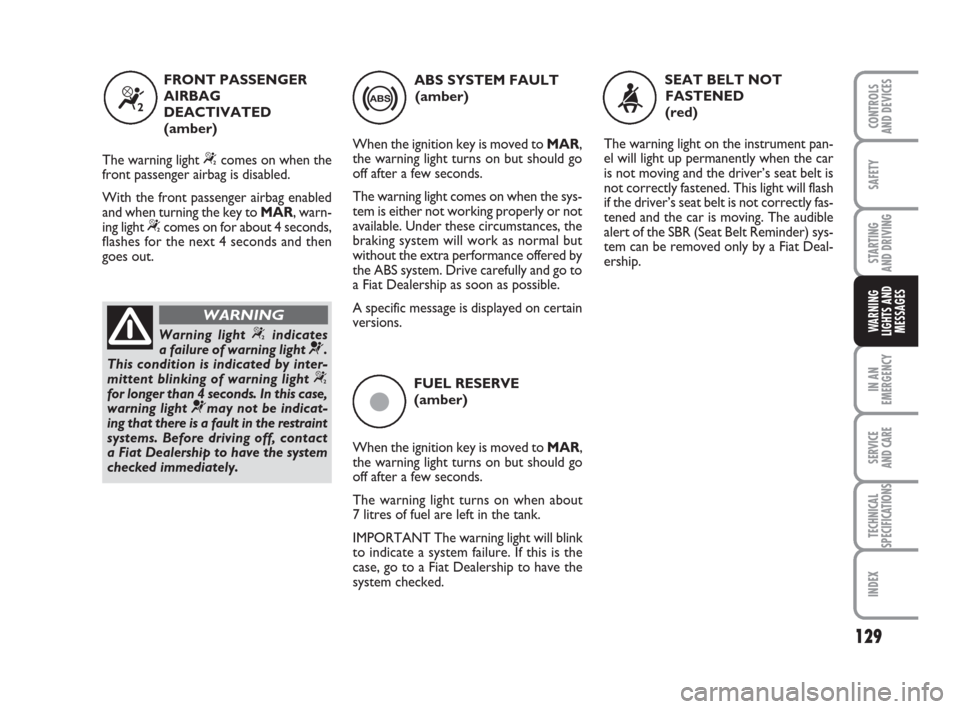
129
SAFETY
STARTING
AND DRIVING
IN AN
EMERGENCY
SERVICE
AND CARE
TECHNICAL
SPECIFICATIONS
INDEX
CONTROLS
AND DEVICES
WARNING
LIGHTS AND
MESSAGES
ç
FUEL RESERVE
(amber)
When the ignition key is moved to MAR,
the warning light turns on but should go
off after a few seconds.
The warning light turns on when about
7 litres of fuel are left in the tank.
IMPORTANT The warning light will blink
to indicate a system failure. If this is the
case, go to a Fiat Dealership to have the
system checked.ABS SYSTEM FAULT
(amber)
When the ignition key is moved to MAR,
the warning light turns on but should go
off after a few seconds.
The warning light comes on when the sys-
tem is either not working properly or not
available. Under these circumstances, the
braking system will work as normal but
without the extra performance offered by
the ABS system. Drive carefully and go to
a Fiat Dealership as soon as possible.
A specific message is displayed on certain
versions.
>“
FRONT PASSENGER
AIRBAG
DEACTIVATED
(amber)
The warning light
“comes on when the
front passenger airbag is disabled.
With the front passenger airbag enabled
and when turning the key to MAR, warn-
ing light
“comes on for about 4 seconds,
flashes for the next 4 seconds and then
goes out.
Warning light
“indicates
a failure of warning light ¬.
This condition is indicated by inter-
mittent blinking of warning light
“for longer than 4 seconds. In this case,
warning light ¬may not be indicat-
ing that there is a fault in the restraint
systems. Before driving off, contact
a Fiat Dealership to have the system
checked immediately.
WARNING
SEAT BELT NOT
FASTENED
(red)
The warning light on the instrument pan-
el will light up permanently when the car
is not moving and the driver’s seat belt is
not correctly fastened. This light will flash
if the driver’s seat belt is not correctly fas-
tened and the car is moving. The audible
alert of the SBR (Seat Belt Reminder) sys-
tem can be removed only by a Fiat Deal-
ership.
<
123-134 ACTUAL 1ed EN 31-08-2010 9:23 Pagina 129
Page 161 of 216
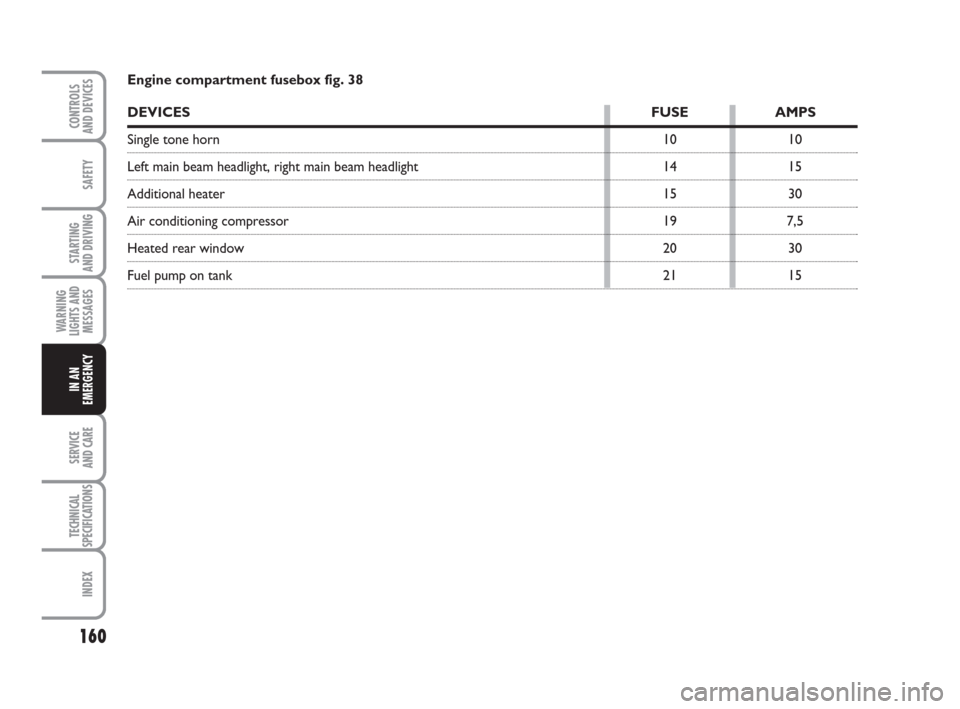
160
SAFETY
STARTING
AND DRIVING
WARNING
LIGHTS AND
MESSAGES
SERVICE
AND CARE
TECHNICAL
SPECIFICATIONS
INDEX
CONTROLS
AND DEVICES
IN AN
EMERGENCY
Engine compartment fusebox fig. 38
DEVICESFUSE AMPS
Single tone horn
Left main beam headlight, right main beam headlight
Additional heater
Air conditioning compressor
Heated rear window
Fuel pump on tank10
14
15
19
20
2110
15
30
7,5
30
15
135-166 ACTUAL 1ed EN 26-07-2010 16:00 Pagina 160
Page 171 of 216

170
SAFETY
STARTING
AND DRIVING
WARNING
LIGHTS AND
MESSAGES
IN AN
EMERGENCY
TECHNICAL
SPECIFICATIONS
INDEX
CONTROLS
AND DEVICES
SERVICE
AND CARE
If the vehicle is used mainly around town or the annual distance travelled is less than 10,000 km, the engine oil
and oil filter must be changed every 12 months.
Thousands of kilometres
Check exhaust gas emissions
Check battery charge status and possibly recharg
Replace air filter cartridge
Top up fluid levels (engine coolant, brakes,
battery, windscreen washer, etc.)
Check condition of timing belt
Check engine management system operation
(through diagnostic socket)
Replace spark plugs
Replace toothed timing belt (*)
Change engine oil and replace oil filter (or every 24 months)
Change brake fluid (or every 24 months)
Replace pollen filter (or every 24 months)
(*) Regardless of the distance covered, the timing belt should be replaced every 4 years for particularly demanding use (cold climates, city driving, idling for a long
time, dusty areas) or in any case every 5 years.
30 60 90 120 150 180
●●●●● ●
●●●●● ●
●● ●
●●●●● ●
●●
●●●●● ●
●●●●● ●
●
●●●●● ●
●● ●
●●●●● ●
167-186 ACTUAL 1ed EN 18-01-2011 16:31 Pagina 170
Page 174 of 216
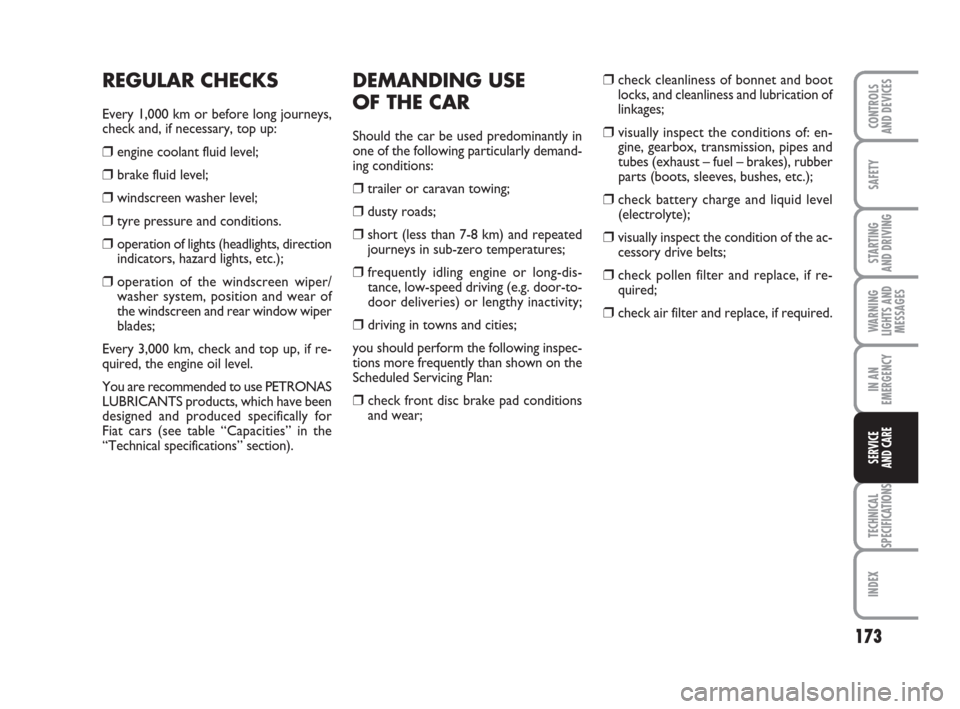
173
SAFETY
STARTING
AND DRIVING
WARNING
LIGHTS AND
MESSAGES
IN AN
EMERGENCY
TECHNICAL
SPECIFICATIONS
INDEX
CONTROLS
AND DEVICES
SERVICE
AND CARE
DEMANDING USE
OF THE CAR
Should the car be used predominantly in
one of the following particularly demand-
ing conditions:
❒trailer or caravan towing;
❒dusty roads;
❒short (less than 7-8 km) and repeated
journeys in sub-zero temperatures;
❒ frequently idling engine or long-dis-
tance, low-speed driving (e.g. door-to-
door deliveries) or lengthy inactivity;
❒ driving in towns and cities;
you should perform the following inspec-
tions more frequently than shown on the
Scheduled Servicing Plan:
❒ check front disc brake pad conditions
and wear;
❒check cleanliness of bonnet and boot
locks, and cleanliness and lubrication of
linkages;
❒ visually inspect the conditions of: en-
gine, gearbox, transmission, pipes and
tubes (exhaust – fuel – brakes), rubber
parts (boots, sleeves, bushes, etc.);
❒check battery charge and liquid level
(electrolyte);
❒visually inspect the condition of the ac-
cessory drive belts;
❒check pollen filter and replace, if re-
quired;
❒check air filter and replace, if required.
REGULAR CHECKS
Every 1,000 km or before long journeys,
check and, if necessary, top up:
❒engine coolant fluid level;
❒brake fluid level;
❒windscreen washer level;
❒tyre pressure and conditions.
❒operation of lights (headlights, direction
indicators, hazard lights, etc.);
❒operation of the windscreen wiper/
washer system, position and wear of
the windscreen and rear window wiper
blades;
Every 3,000 km, check and top up, if re-
quired, the engine oil level.
You are recommended to use PETRONAS
LUBRICANTS products, which have been
designed and produced specifically for
Fiat cars (see table “Capacities” in the
“Technical specifications” section).
167-186 ACTUAL 1ed EN 27-07-2010 10:30 Pagina 173
Page 180 of 216

179
SAFETY
STARTING
AND DRIVING
WARNING
LIGHTS AND
MESSAGES
IN AN
EMERGENCY
TECHNICAL
SPECIFICATIONS
INDEX
CONTROLS
AND DEVICES
SERVICE
AND CARE
AIR FILTER
Have the air filter replaced by a Fiat Deal-
ership.
POLLEN FILTER
Have the pollen filter replaced by a Fiat
Dealership.
Symbol πon the container
indicates a synthetic brake
fluid, which is different from a min-
eral fluid. Using a mineral-type fluid
will damage the special rubber seals
of the braking system beyond repair.
WARNINGBATTERY
The battery is of the “Limited mainte-
nance” type: under normal conditions of
use, the electrolyte does not need topping
up with distilled water.
The battery fluid is poiso-
nous and corrosive. Avoid
contact with the skin and eyes. Keep
naked flames or possible sources of
sparks away from the battery: risk of
explosion or fire.
WARNING
CHECKING THE CHARGE
AND THE ELECTROLYTE LEVEL
Inspection operations must be carried out
only by specialised personnel, following
the prescriptions contained in this Own-
er Handbook. Any top-up operations
must be carried out only by specialised
personnel at a Fiat Dealership.
Using the battery when the
fluid is too low can damage
it irreparably and generate a risk of
explosion.
WARNING
REPLACING THE BATTERY
If required, replace the battery with an
original spare part with the same specifi-
cations.
If a battery with different specifications is
fitted, the service intervals given in the
“Scheduled Servicing Plan” will no longer
be valid.
For battery maintenance, you should
therefore refer to the instructions pro-
vided by the battery manufacturer.
167-186 ACTUAL 1ed EN 27-07-2010 10:30 Pagina 179
Page 185 of 216
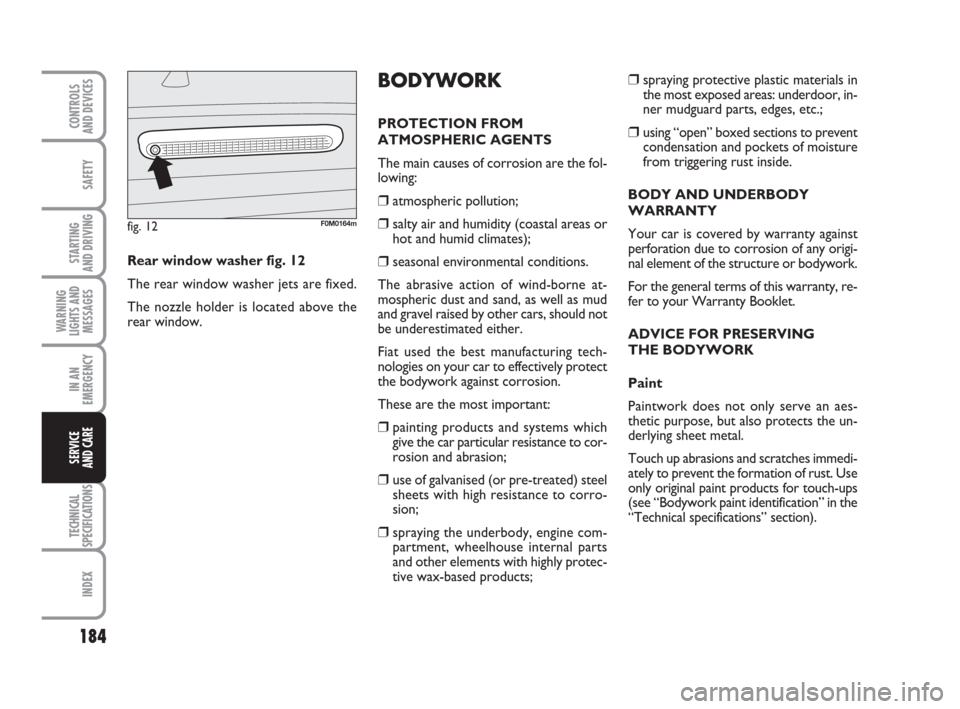
184
SAFETY
STARTING
AND DRIVING
WARNING
LIGHTS AND
MESSAGES
IN AN
EMERGENCY
TECHNICAL
SPECIFICATIONS
INDEX
CONTROLS
AND DEVICES
SERVICE
AND CARE
❒spraying protective plastic materials in
the most exposed areas: underdoor, in-
ner mudguard parts, edges, etc.;
❒using “open” boxed sections to prevent
condensation and pockets of moisture
from triggering rust inside.
BODY AND UNDERBODY
WARRANTY
Your car is covered by warranty against
perforation due to corrosion of any origi-
nal element of the structure or bodywork.
For the general terms of this warranty, re-
fer to your Warranty Booklet.
ADVICE FOR PRESERVING
THE BODYWORK
Paint
Paintwork does not only serve an aes-
thetic purpose, but also protects the un-
derlying sheet metal.
Touch up abrasions and scratches immedi-
ately to prevent the formation of rust. Use
only original paint products for touch-ups
(see “Bodywork paint identification” in the
“Technical specifications” section).
BODYWORK
PROTECTION FROM
ATMOSPHERIC AGENTS
The main causes of corrosion are the fol-
lowing:
❒atmospheric pollution;
❒salty air and humidity (coastal areas or
hot and humid climates);
❒seasonal environmental conditions.
The abrasive action of wind-borne at-
mospheric dust and sand, as well as mud
and gravel raised by other cars, should not
be underestimated either.
Fiat used the best manufacturing tech-
nologies on your car to effectively protect
the bodywork against corrosion.
These are the most important:
❒painting products and systems which
give the car particular resistance to cor-
rosion and abrasion;
❒use of galvanised (or pre-treated) steel
sheets with high resistance to corro-
sion;
❒spraying the underbody, engine com-
partment, wheelhouse internal parts
and other elements with highly protec-
tive wax-based products; Rear window washer fig. 12
The rear window washer jets are fixed.
The nozzle holder is located above the
rear window.
fig. 12F0M0164m
167-186 ACTUAL 1ed EN 27-07-2010 10:30 Pagina 184